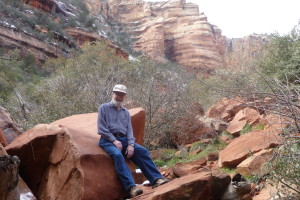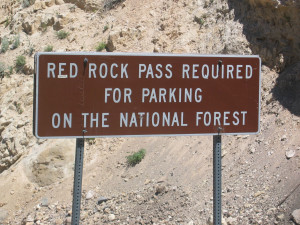U.S. vs James T. Smith
 BACKGROUND: The Red Rock area of Sedona, Arizona is located at the southern edge of the uplifted Colorado Plateau. An eroded escarpment called the Mogollon Rim marks an abrupt change in elevation from around 7,000 feet up on the Plateau to around 4,500 feet at Sedona. Erosion has carved out sheer 2,000-foot cliffs and a fairyland of intricate canyons and dazzling rock formations. The iron minerals leaching out from some of the rock layers have stained the rocks with shades of earthy red, giving the “Red Rock” area its name. In the middle of it all, Oak Creek runs as a sparkling gem through its own magnificent canyon.
BACKGROUND: The Red Rock area of Sedona, Arizona is located at the southern edge of the uplifted Colorado Plateau. An eroded escarpment called the Mogollon Rim marks an abrupt change in elevation from around 7,000 feet up on the Plateau to around 4,500 feet at Sedona. Erosion has carved out sheer 2,000-foot cliffs and a fairyland of intricate canyons and dazzling rock formations. The iron minerals leaching out from some of the rock layers have stained the rocks with shades of earthy red, giving the “Red Rock” area its name. In the middle of it all, Oak Creek runs as a sparkling gem through its own magnificent canyon.
The region is the destination of a large number of visitors, many of them coming to hike in the Coconino National Forest or stay at the campgrounds in Oak Creek Canyon. While the Forest Service has for a long time charged fees for use of the campgrounds, the agency established the Red Rock Pass Area after the passage of the Recreational Fee Demonstration Program (Fee Demo) by Congress in 1996. This large 160,000 acre area included all of the National Forest land around Sedona, and for the first time hikers had to pay a fee just to park on National Forest land and go hiking. The new fee program was just as controversial in Sedona as it was elsewhere.
Congress responded to widespread opposition to the new recreation fees by repealing Fee Demo in 2004, and in its place enacted the Federal Lands Recreation Enhancement Act (FLREA). FLREA authorizes the Forest Service to charge an amenity fee for an area that has a required list of amenities, such as picnic tables and a permanent toilet, all of which must be present. In FLREA, there are specific provisions that prohibit the Forest Service from charging a fee solely for parking in an undeveloped area, or for hiking across the National Forest.
 The Coconino National Forest issued a news release in June 2005 stating that the Red Rock Pass Area qualified as a High-Impact Recreation Area (HIRA) under new agency guidelines, and that a recreation fee would continue to be charged whenever a person parked on National Forest lands. As far as the Forest Service was concerned, the 160,000 acre Red Rock HIRA was a qualifying “area” under FLREA, since there are places within it that contain picnic tables, public toilets, etc. The prohibitions on charging fees for parking at undeveloped trailheads and walking across National Forest land were ignored.
The Coconino National Forest issued a news release in June 2005 stating that the Red Rock Pass Area qualified as a High-Impact Recreation Area (HIRA) under new agency guidelines, and that a recreation fee would continue to be charged whenever a person parked on National Forest lands. As far as the Forest Service was concerned, the 160,000 acre Red Rock HIRA was a qualifying “area” under FLREA, since there are places within it that contain picnic tables, public toilets, etc. The prohibitions on charging fees for parking at undeveloped trailheads and walking across National Forest land were ignored.
But they didn’t know they had a fee hero in their midst.
On November 2, 2009, mild-mannered Sedona retiree Jim Smith received a violation notice while parked at the Dry Creek/Vultee Arch trailhead without displaying a Red Rock Pass. The closest picnic tables, public toilet and trash receptacle – all amenities that are required for charging an amenity fee under FLREA – are 7 to 10 miles away from this trailhead. Since the Flagstaff court is closed during the winter, Jim used the winter months to prepare a Motion to Dismiss challenging the legality of the Forest Service’s use of the HIRA designation to charge him a recreation fee. His motion was submitted to the court in April 2010. Following the filing of a series of legal documents by both sides, Magistrate Judge Mark Aspey dismissed the citation on September 14th, and ruled that the Forest Service’s practice of charging fees throughout the entire Red Rock HIRA was contrary to the clear statutory language of the FLREA.
Jim would like to post the following acknowledgements:
“This morning a Flagstaff reporter called the U.S. Attorney’s office in Flagstaff, and was told the government will not appeal the decision by Judge Mark Aspey to dismiss the citation I received for not displaying a Red Rock Pass. The judge had ruled that the HIRA designation could not be used to charge fees for parking and hiking in undeveloped areas of the Red Rocks.
This brings to an end the litigation that began November 2, 2009 when I received a violation notice while parked at the Dry Creek/Vultee Arch trailhead near Sedona. I can now cease writing legal briefs, and get back to more productive things. Before I do that, I need to thank the many people in the no-fee community who helped me bring this “project” to a successful conclusion.
Major thanks goes to Kitty Benzar, who maintains the westernslopenofee.org website. Kitty has been instrumental from the start with advice and encouragement. As I have gradually learned more about her activities in this area, I am amazed at her energy and level of involvement. She has attended Congressional oversight hearings, testified before Congressional committees, attended Recreational Resource Advisory Committee (RRAC) meetings across the country, seems to always be traveling to some meeting related to decisions on recreation fees, and writes a steady stream of comments on numerous blogs and websites, as well as maintaining her website. And that’s just the stuff I know about.
The Forest Service didn’t appeal because it didn’t have any grounds to appeal. They didn’t have any grounds to appeal because I had access to the court documents from US vs Wallace on the WSNFC website when I wrote my Motion to Dismiss. Chris Wallace in Tucson sparked no-fee litigation in Arizona when she fought citations she received while hiking in the Mt. Lemmon area. After a magistrate judge dismissed her citations, they were reinstated by the District Judge. The Forest Service then dropped the one charge that could have been appealed. It’s turning into a costly victory for them, because I used those documents to find and counter in my motion every one of the distortions in statutory language they used, as well as show that a HIRA was not necessary to efficiently collect legitimate fees. Mt. Lemmon is now headed for the Ninth Circuit Court anyway, in the form of a civil suit. And Chris, who is a paralegal, managed to get in one more lick against the Forest Service, when she edited and formatted my motion.
Mary Ellen Barilotti wrote the legal briefs for Chris, and I used the motion that she wrote in that case as a guide to writing my own. In some places I was able to do a “cut and paste” for legal language and case histories. Mary Ellen also reviewed my briefs, and gave a lot of really good advice. Many thanks. Matt Kenna got involved late in the game, but gave some useful advice. He is now taking the Mt. Lemmon and Mt. Evans civil suits to the 9th and 10th Circuit Courts. I am hoping he will be able to take advantage of Judge Aspey’s opinion.
I don’t want to forget to mention Kristi Laguzza-Boosman. It was during my very first internet search about Forest Service recreation fees that I came upon an article about her citation in Washington state getting thrown out of court. It inspired me to start to think about doing the same thing. (I have to say though, I had no idea about how much effort it would take!)
Steve Saway gave some really important assistance in understanding the negligence on the part of the Forest Service in not seeking approval for any of the Arizona HIRAs from the Arizona RRAC. The Judge specifically noted this in his opinion, and that is probably one reason the Forest Service will not (make that “can not”) appeal.
There are many people I haven’t mentioned who have helped, both directly with encouragement, advice or information, or indirectly by writing articles and letters to editors, posting on blogs, and supporting the no-fee effort. There are a huge number of people who care deeply about our public lands, are fighting to keep them freely accessible. Thanks to all of you.”
Jim
Legal Filings – U.S. vs Smith
US v Smith Complaint
US v Smith Motion to Dismiss
US v Smith Govt Response
US v Smith Smith Reply
US v Smith Order for Supplemental Information
US v Smith Govt Supplemental Information
US v Smith Smith Supplemental Information
US v Smith Decision
Media – U.S. vs Smith
2010 09 26 Judge Dismisses Red Rocks Ticket
2010_09_21_Forest_Fees_Struck_Down
2010 09 22 Case Could End HIRA Fees
2010 09 23 Sedonan Wins In Court
2010 09 23 Make Fees Fit Use
2010 09 21 Red Rock Fees In Legal Limbo
2010 09 29 Earth To Forest Service
2010 09 29 Finally Our Day In Court
2010 10 01 Judge Rules Against Red Rock Pass
2010 10 01 Smith Letter to Red Rock News
2010 09 30 Outdoor Access Should Be Free
2010 10 15 Red Rock Pass Scope Reduced
2010 10 16 Court Reins In Red Rock Pass
2010 10 23 Coconino Backs Off
2010 10 27 Red Rock Pass Changes
2010 10 27 Red Rock Pass Interim Changes
2010 10 27 FS Press Release
2011 04 01 Stormy Weather for Red Rock Pass
2011 06 01 Federal Register Notice of RecRAC Field Trip
2011 06 02 Red Rock Pass Changes
2011 06 01 This Land Is Your Land Or Is It
The Law and the Ruling
THIS IS A HANDOUT THAT THE COCONINO NATIONAL FOREST REFUSED TO ALLOW TO BE READ ALOUD AT A PUBLIC MEETING ON MARCH 1, 2011.
The Law And The Ruling
